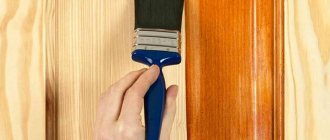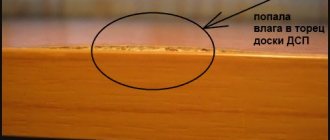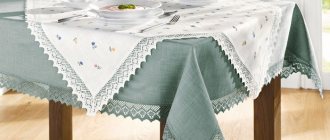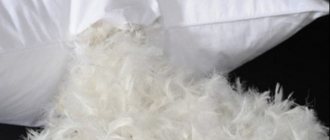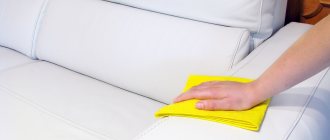Types of stains and their differences
Water stain (migratory stain).
The base is water. Thinner: water. No smell
- Easy to apply
- Gives uniform color
- More economical than solvent-based stains
- Slow drying
- Penetrates deeply into the wood texture
- Raise the pile
- The subsequent applied layers of aqueous materials migrate (color). To prevent the process of migration (staining), it is necessary to carefully fix the water-based stain with any non-aqueous varnish.
- If applied intensively, they can saturate the wood with moisture and deform it.
Alcohol stain (stain). Thinner: alcohol, acetone.
- Dries quickly
- Doesn't raise the pile
- They do not migrate after drying, i.e. allow you to work with any water-based materials over a tinted surface.
- Penetration into the wood structure is not as deep as with water-based stains, which simplifies the work of additionally highlighting the wood structure with abrasive materials.
- do not saturate wood, do not cause swelling of fibers.
- have a pronounced alcohol smell, and natural colors have a strong acetone smell. It is recommended to work in a well-ventilated area.
Universal stain (stain). Thinner - water, alcohol, acetone.
- It has all the properties of water stains (see above). The thinner alcohol or acetone only allows the stain to dry faster on the surface.
- BE CAREFUL!!!! Even if you dilute the universal stain with alcohol or acetone, without intermediate varnish the STAIN WILL MIGRATE!!!
What are “beaters” in furniture?
Paints are coloring compounds intended for decorative finishing of wood while preserving its natural structure.
Essentially, these are stains that oxidize the wooden surface, as well as compositions containing a variety of coloring pigments. With their help, you can transform even the most inexpressive types of wood, emphasizing their natural relief.
Previously, stains were used only to give wood a brown color and had only a mordant effect. For their production, exclusively natural raw materials were used.
Oil-based colored stains.
Only a few natural compositions have survived to this day: natural nut stain - based on nuts, and humic brown - from salts of humic acids, which are found in peat, soil, and coal.
Modern production has expanded the range, producing compositions that allow painting in almost any color. In addition to the decorative effect, tinting solutions also impart protective properties to the surfaces being treated.
All fighters are divided into two categories:
- aquatic;
- not aquatic.
Water-based - designed for coloring and tinting various types of wood and are available in a wide variety of colors. They are used for treating wooden surfaces indoors - furniture, trim, window frames, stairs, railings, floors.
When used in outdoor work, the product coated with stain is additionally coated with a protective varnish.
Water stains are applied to the product in one or several layers, depending on the desired result. After applying each layer, the surface must be thoroughly dried, after which the quality of the application can be assessed. Wood treated in this way acquires a pronounced wood pattern and resistance to abrasion.
Non-water stains include synthetic resins, organic solvents and dyes that can highlight the structure of various types of wood. This composition is well absorbed and dries quickly, preventing the surface from swelling.
To achieve uniform coverage with an alcohol composition, it is better to use a manual or pneumatic spray gun.
Unlike water-based, it does not require subsequent varnishing. They are used for both external and internal work.
There is a technology for using stains on different bases for processing different types of wood. For example, water-based compositions adhere better to the surface of beech, emphasizing an even, uniform structure. Alcohol stains are used to treat resinous wood.
An example of stain tinting.
“Independent” types of beys are produced on the basis of:
- chemical;
- oil
Chemical stains include soluble metal salts instead of dyes. Surface coloring occurs when salts react with tannins that make up wood.
Oil stains have protective properties, penetrating the surface structure and protecting it from rotting. Used in the manufacture of carpentry, flooring and furniture while preserving the natural structure of wood. They have a wide range of colors.
Based on the type of dye used in the composition, stains are divided into:
- organic;
- synthetic.
Synthetic-based solutions are more widely used. They contain coloring pigments that are used in the production of paints.
Organically based beans are more expensive. They contain various resins that serve to create the effect of different structures. To even out the color, nitro resins are added to the composition.
Recommendations for applying stains
- Before applying stain, sand the surface thoroughly. It is necessary to work with an abrasive material along the grain of the wood; scratches across the grain will be emphasized by the stain and will stand out. The different tone of the stain (different absorbency) will depend on the grain size of the abrasive.
- Before painting an object, it is better to do a test painting. The painting is done on the same material from which the product is made. The result of the surface color is assessed only after complete drying and varnishing, because the color changes significantly.
- When using water-based stains, it is recommended to pre-treat the wood with water. And after drying, sand off the raised pile. Then, after applying water stain, the raising of the pile will be minimized.
- To apply stains to a large, flat surface, it is better to use the widest brush possible.
- It is better to apply the stain liberally and evenly, always along the grain. It is very important to have time to combine wet edges, so with stains, especially alcohol stains, you need to work quickly and without interruptions.
- For a more even application of alcohol stains on large surfaces, you can use a special “Polishing Glaze”, which increases the drying time of the alcohol stain and allows you to spread it over the surface without leaving any traces of joints.
- Since stains are very fluid for processing vertical surfaces and turning products, it is better to use a paint pad, foam rubber or any rag.
What is wood stain used for?
The main function of the solution is long-lasting decorative impregnation and protection of products, but there are also additional possibilities. The bases, methods of influencing the surface, and color intensity differ.
- When choosing a composition, consider the following characteristics:
- Transparency. Mixtures can be opaque, partially or completely transparent.
- Wear resistance. For floor coverings, a specialized rustic stain is used.
- Heat resistance. Different impregnations are used for interior and exterior work.
- Moisture protection.
- Additives of antiseptics and fungicides to prevent damage by mold, mildew, and wood-boring insects.
- Fire retardant (fire-fighting) components.
Understanding what stain does to wood, you can achieve complete restoration of outdated wooden products: shade the wood, protect it from external factors, and give valuable things a second life.
Toning
Staining imitates elite breeds without the expense of expensive materials. The largest palette is presented among aqueous solutions. There are 3 color schemes:
- Natural – natural wood shades: maple, walnut, cherry, wenge, oak.
- Neutral - white, gray and black.
- Plain color (red, blue, green, purple), designer selections.
The possibilities for the decorative effect of stain are enormous, up to the point of radically transforming the wood.
General characteristics of ProArt stains:
- All ProArt stains are concentrates that can and should be diluted to the desired saturation. When using concentrates in their pure form, the result is a strong, extremely dark or saturated color from one coat of coating.
- Subject to storage rules, the shelf life of stains is unlimited.
- Before use, be sure to thoroughly mix the stain to achieve uniformity of the material.
- All stain colors of one base mix perfectly with each other to obtain the desired color and shade.
ArtBlank.
Low pressure diaphragm pump VS 36
- manufacturer: ValSpray
The low pressure diaphragm pump VS 36 is the ideal solution for professional industrial painting. Thanks to its small dimensions, it is ideal for both stationary and mobile painting stations, for powering...
more details
in stock
€577.35
How to make stain with your own hands?
How to make stain with your own hands?
You can prepare something like a stain at home with your own hands. Several recipes:
- For a brown shade . Grind the walnut shell into powder, put it in water, boil the powder for 10-20 minutes, strain the resulting coloring solution through a sieve and cool.
- For a reddish-brown shade . Take 200-300 g of onion peel, boil it in 1 liter of water, strain the solution through a sieve and cool.
- To lighten wood . Mix a 40% hydrogen peroxide solution and a 30% ammonia solution in a ratio of 9 to 1, mix the resulting mixture thoroughly.
Useful tips
Let's look at some important tips:
- Do not apply the composition in the cold. Stain adheres very poorly to a wooden surface at low temperatures, so you will get uneven toning.
- If you are working with coniferous wood , then after removing the old paint/varnish you need to deresin the wood. Mix 100 g of acetone and 400 g of water, cover the surface of the wood with the mixture, rinse it off after 30 minutes and dry the wood.
- If you want to get a light cherry color of wood , then instead of stain you can use potassium permanganate for impregnation. Dissolve 50 g of potassium permanganate in 1 liter of water, saturate the wood with the mixture in 2 approaches.
In conclusion, I would like to note that when choosing a stain, you should not skimp. People usually buy cheap water-based compounds, but they need to remember that they are only suitable for finishing wood inside the house. If you want to tint outdoor wood structures or expensive items, be sure to buy acrylic, oil or wax stain. Let you pay an additional 600-700 rubles, but the effect of tinting will last for many years.
Wood stain video
Features of the composition of Beitz Vidaron
Vidaron stain is an excellent finishing product for parquet and wooden floors, stairs and panels, furniture, antiques and many other wood products. It can also be used to achieve a wood effect on painted metal, glass or plastic surfaces.
- The decorative product perfectly combines components that give an excellent finishing result of a beautiful and impressive surface of a wooden product.
- A high-quality tinting composition is able to deeply and evenly saturate wood pores without lifting fibers or creating stains on the surface.
- Vidaron stain has antiseptic capabilities, forms a wood coating that emphasizes the natural beauty, while protecting the wood from numerous harmful and destructive influences, and extending the service life of the treated product.
- The stain is available in many shades of satin sheen, with which you can quickly and easily achieve a beautiful decorative effect.
